Temporal and Spatial Dynamics of Dust Storms in Uzbekistan from Meteorological Station Records (2010–2023)
Abstract
1. Introduction
2. Materials and Methods
2.1. Study Domain
2.2. Observations from Meteorological Stations Across Uzbekistan
2.3. ERA5 Reanalysis
3. Results
3.1. Spatiotemporal Distribution of SDS Events
3.2. Seasonal Distribution of SDS Events
3.3. Analysis of Wind Activity SDS
4. Discussion
5. Conclusions
Author Contributions
Funding
Institutional Review Board Statement
Informed Consent Statement
Data Availability Statement
Acknowledgments
Conflicts of Interest
References
- Middleton, N.; Kang, U. Sand and Dust Storms: Impact Mitigation. Sustain. Sci. Pract. Policy 2017, 9, 1053. [Google Scholar] [CrossRef]
- Middleton, N.; Tozer, P.; Tozer, B. Sand and Dust Storms: Underrated Natural Hazards. Disasters 2019, 43, 390–409. [Google Scholar] [CrossRef] [PubMed]
- Jiao, P.; Wang, J.; Chen, X.; Ruan, J.; Ye, X.; Alavi, A.H. Next-Generation Remote Sensing and Prediction of Sand and Dust Storms: State-of-the-Art and Future Trends. Int. J. Remote Sens. 2021, 42, 5277–5316. [Google Scholar] [CrossRef]
- Khromov, S.P.; Mamontova, L.I. Meteorological Dictionary; Gidrometeoizdat: Leningrad, Russia, 1974. [Google Scholar]
- Leukhina, G.; Lyapina, O.; Veremeeva, T. Climate of Uzbekistan; SANIGMI: Tashkent, Uzbekistan, 1996. [Google Scholar]
- UNCCD. Policy Advocacy Framework for Sand and Dust Storms. In Draft Advocacy Policy Frameworks: Gender, Drought, and Sand and Dust Storms, ICCD/COP(13)/19, Proceedings of the Conference of the Parties, Thirteenth Session, Item 3 (d) of the Provisional Agenda, Ordos, China, 6–16 September 2017; UNCCD: Bonn, Germany, 2017. [Google Scholar]
- Indoitu, R.; Orlovsky, L.; Orlovsky, N. Dust Storms in Central Asia: Spatial and Temporal Variations. J. Arid Environ. 2012, 85, 62–70. [Google Scholar] [CrossRef]
- Youlin, Y.; Squires, V.; Qi, L. Global Alarm: Dust and Sandstorms from the World’s Drylands; United Nations Convention to Combat Desertification (UNCCD): Bonn, Germany, 2002. [Google Scholar]
- Nishonov, B.E.; Kholmatjanov, B.M.; Labzovskii, L.D.; Rakhmatova, N.; Shardakova, L.; Abdulakhatov, E.I.; Yarashev, D.U.; Toderich, K.N.; Khujanazarov, T.; Belikov, D.A. Study of the strongest dust storm occurred in Uzbekistan in November 2021. Sci. Rep. 2023, 13, 20042. [Google Scholar] [CrossRef]
- Middleton, N.J. Desert Dust Hazards: A Global Review. Aeolian Res. 2017, 24, 53–63. [Google Scholar] [CrossRef]
- UNCCD. Sand and Dust Storms Compendium: Information and Guidance on Assessing and Addressing the Risks; United Nations Convention to Combat Desertification (UNCCD): Bonn, Germany, 2022. [Google Scholar]
- UNEP; WMO; UNCCD. Global Assessment of Sand and Dust Storms; United Nations Environment Programme: Nairobi, Kenya, 2016. [Google Scholar]
- Goudie, A.S. Desert Dust and Human Health Disorders. Environ. Int. 2014, 63, 101–113. [Google Scholar] [CrossRef] [PubMed]
- Ravi, S.; D’Odorico, P.; Breshears, D.D.; Field, J.P.; Goudie, A.S.; Huxman, T.E.; Li, J.; Okin, G.S.; Swap, R.J.; Thomas, A.D.; et al. Aeolian Processes and the Biosphere. Rev. Geophys. 2011, 49, RG3001. [Google Scholar] [CrossRef]
- Goudie, A.S.; Middleton, N.J. Desert Dust in the Global System; Springer Science & Business Media: Berlin/Heidelberg, Germany, 2006; ISBN 9783540323556. [Google Scholar]
- Chen, Z.; Gao, X.; Lei, J. Dust Emission and Transport in the Aral Sea Region. Geoderma 2022, 428, 116177. [Google Scholar] [CrossRef]
- Shardakova, L.; Akhmedova, A.; Rakhmatova, N.; Nishonov, B. Analysis of Dust Storms in Surkhandarya Region Based on Ground Observation Data. Hydrometeorol. Environ. Monit. 2024, 3, 88–99. [Google Scholar]
- Shardakova, L.Y.; Akhmedova, A.R.; Rakhmatova, N.I.; Nishonov, B.E. Spatiotemporal Analysis of Dust Storms in the Aral Sea Region for 2010-2021. Hydrometeorol. Environ. Monit. 2022, 4, 90–99. [Google Scholar]
- Romanov, N.N. Dust Storms in Central Asia; SamGU: Tashkent, Uzbekistan, 1960. [Google Scholar]
- Sapozhnikova, S.A. Map-Scheme of the Number of Days with Dust Storms in the Southern Zone of the USSR and in the Adjacent Territories. Tr. Nauchno-Issledovatelskogo Instituta Aeroklimatologii 1970, 65, 61–68. [Google Scholar]
- Chirkov, Y.I. Recurrence of Dust Storms in the Territory of the USSR and the Possibility of Predicting Their Occurrence. Proc. USSR Hydrometeorol. Cent. 1970, 69, 109–119. [Google Scholar]
- Shardakova, L.Y.; Usmanova, L.V. Analysis of Dust Storms in the Aral Sea Region. Probl. Desert Dev. 2006, 3, 30–34. [Google Scholar]
- Shao, Y.; Dong, C.H. A Review on East Asian Dust Storm Climate, Modelling and Monitoring. Glob. Planet. Change 2006, 52, 1–22. [Google Scholar] [CrossRef]
- Shen, H.; Abuduwaili, J.; Samat, A.; Ma, L. A Review on the Research of Modern Aeolian Dust in Central Asia. Arab. J. Geosci. 2016, 9, 625. [Google Scholar] [CrossRef]
- Zhang, X.-X.; Claiborn, C.; Lei, J.-Q.; Vaughan, J.; Wu, S.-X.; Li, S.-Y.; Liu, L.-Y.; Wang, Z.-F.; Wang, Y.-D.; Huang, S.-Y.; et al. Aeolian Dust in Central Asia: Spatial Distribution and Temporal Variability. Atmos. Environ. 2020, 238, 117734. [Google Scholar] [CrossRef]
- Wang, W.; Samat, A.; Abuduwaili, J.; Ge, Y.; De Maeyer, P.; Van de Voorde, T. Temporal Characterization of Sand and Dust Storm Activity and Its Climatic and Terrestrial Drivers in the Aral Sea Region. Atmos. Res. 2022, 275, 106242. [Google Scholar] [CrossRef]
- Wang, W.; Samat, A.; Abuduwaili, J.; De Maeyer, P.; Van de Voorde, T. Machine Learning-Based Prediction of Sand and Dust Storm Sources in Arid Central Asia. Int. J. Digit. Earth 2023, 16, 1530–1550. [Google Scholar] [CrossRef]
- Nobakht, M.; Shahgedanova, M.; White, K. New Inventory of Dust Emission Sources in Central Asia and Northwestern China Derived from MODIS Imagery Using Dust Enhancement Technique. J. Geophys. Res. 2021, 126, e2020JD033382. [Google Scholar] [CrossRef]
- Hersbach, H.; Bell, B.; Berrisford, P.; Hirahara, S.; Horányi, A.; Muñoz-Sabater, J.; Nicolas, J.; Peubey, C.; Radu, R.; Schepers, D.; et al. The ERA5 Global Reanalysis. Quart. J. Roy. Meteor. Soc. 2020, 146, 1999–2049. [Google Scholar] [CrossRef]
- Soci, C.; Hersbach, H.; Simmons, A.; Poli, P.; Bell, B.; Berrisford, P.; Horányi, A.; Muñoz-Sabater, J.; Nicolas, J.; Radu, R.; et al. The ERA5 Global Reanalysis from 1940 to 2022. Q. J. R. Meteorol. Soc. 2024, 150, 4014–4048. [Google Scholar] [CrossRef]
- Wang, N.; Chen, J.; Zhang, Y.; Xu, Y.; Yu, W. The Spatiotemporal Characteristics and Driving Factors of Dust Emissions in East Asia (2000–2021). Remote Sens 2023, 15, 410. [Google Scholar] [CrossRef]
- Wang, W.; He, S.; Guo, H.; Abuduwaili, J.; Samat, A.; De Maeyer, P.; Van de Voorde, T. Sand and Dust Storm Risk Assessment in Arid Central Asia: Implications for the Environment, Society, and Agriculture. Int. J. Disaster Risk Sci. 2024, 15, 703–718. [Google Scholar] [CrossRef]
- Alshammari, R.K.; Alrwais, O.; Aksoy, M.S. Machine Learning Forecast of Dust Storm Frequency in Saudi Arabia Using Multiple Features. Atmos 2024, 15, 520. [Google Scholar] [CrossRef]
- Alshammari, R.K.; Alrwais, O.; Aksoy, M.S. Machine Learning Applications to Dust Storms: A Meta-Analysis. Aerosol Air Qual. Res. 2022, 22, 220183. [Google Scholar] [CrossRef]
- Mutawa, A.; Alshaibani, A.; Almatar, L.A. A Comprehensive Review of Dust Storm Detection and Prediction Techniques: Leveraging Satellite Data, Ground Observations, and Machine Learning. IEEE Access 2025, 13, 39694–39710. [Google Scholar] [CrossRef]
- Du, S.; Chen, S.; Cheng, S.; He, J.; Zhao, D.; Zhu, X.; Lian, L.; Tu, X.; Zhao, Q.; Zhang, Y. Dust Storm Detection for Ground-Based Stations with Imbalanced Machine Learning. Environ. Model. Softw. 2025, 188, 106420. [Google Scholar] [CrossRef]
- UzHydromet. The Fourth National Communication of the Republic of Uzbekistan to the UN Framework Convention on Climate Change; UzHydromet: Tashkent, Uzbekistan, 2024. [Google Scholar]
- Federal Service for Hydrometeorology and Environmental Monitoring (Roshydromet) Code for Operational Transmission of Surface Meteorological Observation Data from the Roshydromet Station Network (KN-01 SYNOP). 2013. Available online: https://meteoinfo.ru/images/media/books-docs/RHM/kn-01-synop.pdf (accessed on 20 June 2025).
- Bespalov, D.P.; Gorodetskiy, O.A. Manual for Hydrometeorological Stations and Posts; Meteorological Observations at Stations; Patr-1. State Committee of the USSR for Hydrometeorology and Environmental Monitoring; Gidrometeoizdat: Leningrad, Russia, 1985. [Google Scholar]
- WMO. Guide to Meteorological Instruments and Methods of Observation; WMO: Geneva, Switzerland, 2017. [Google Scholar]
- Kurosaki, Y.; Mikami, M. Threshold Wind Speed for Dust Emission in East Asia and Its Seasonal Variations. J. Geophys. Res. 2007, 112, D17202. [Google Scholar] [CrossRef]
- Rakhmatova, N.; Arushanov, M.; Shardakova, L. Evaluation of the Perspective of ERA-Interim and ERA5 Reanalyses for Calculation of Drought Indicators for Uzbekistan. Atmosphere 2021, 12, 527. [Google Scholar] [CrossRef]
- Wu, X.; Wu, C.; Lin, Z.; Yang, M. Intra-Seasonal Variations of Dust Activity over East Asia in Spring 2023 and Their Mechanisms. Glob. Planet. Change 2025, 244, 104638. [Google Scholar] [CrossRef]
- Shinoda, M.; Gillies, J.A.; Mikami, M.; Shao, Y. Temperate Grasslands as a Dust Source: Knowledge, Uncertainties, and Challenges. Aeolian Res. 2011, 3, 271–293. [Google Scholar] [CrossRef]
- Kok, J.F.; Parteli, E.J.R.; Michaels, T.I.; Karam, D.B. The Physics of Wind-Blown Sand and Dust. Rep. Prog. Phys. 2012, 75, 106901. [Google Scholar] [CrossRef] [PubMed]
- Marticorena, B.; Bergametti, G. Modeling the Atmospheric Dust Cycle: 1. Design of a Soil-derived Dust Emission Scheme. J. Geophys. Res. 1995, 100, 16415–16430. [Google Scholar] [CrossRef]
- Fécan, F.; Marticorena, B.; Bergametti, G. Parametrization of the Increase of the Aeolian Erosion Threshold Wind Friction Velocity Due to Soil Moisture for Arid and Semi-Arid Areas. Ann. Geophys. 1999, 17, 149–157. [Google Scholar] [CrossRef]
- Kok, J.F. A Scaling Theory for the Size Distribution of Emitted Dust Aerosols Suggests Climate Models Underestimate the Size of the Global Dust Cycle. Proc. Natl. Acad. Sci. USA 2011, 108, 1016–1021. [Google Scholar] [CrossRef]
- Sun, J.; Zhang, M.; Liu, T. Spatial and Temporal Characteristics of Dust Storms in China and Its Surrounding Regions, 1960–1999: Relations to Source Area and Climate. J. Geophys. Res. 2001, 106, 10325–10333. [Google Scholar] [CrossRef]
- Su, L.; Toon, O.B. Saharan and Asian Dust: Similarities and Differences Determined by CALIPSO, AERONET, and a Coupled Climate-Aerosol Microphysical Model. Atmos. Chem. Phys. 2011, 11, 3263–3280. [Google Scholar] [CrossRef]
- Pedregosa, F.; Varoquaux, G.; Gramfort, A.; Michel, V.; Thirion, B.; Grisel, O.; Duchesnay, E. Scikit-Learn: Machine Learning in Python. J. Mach. Learn. Res. 2011, 12, 2825–2830. [Google Scholar]

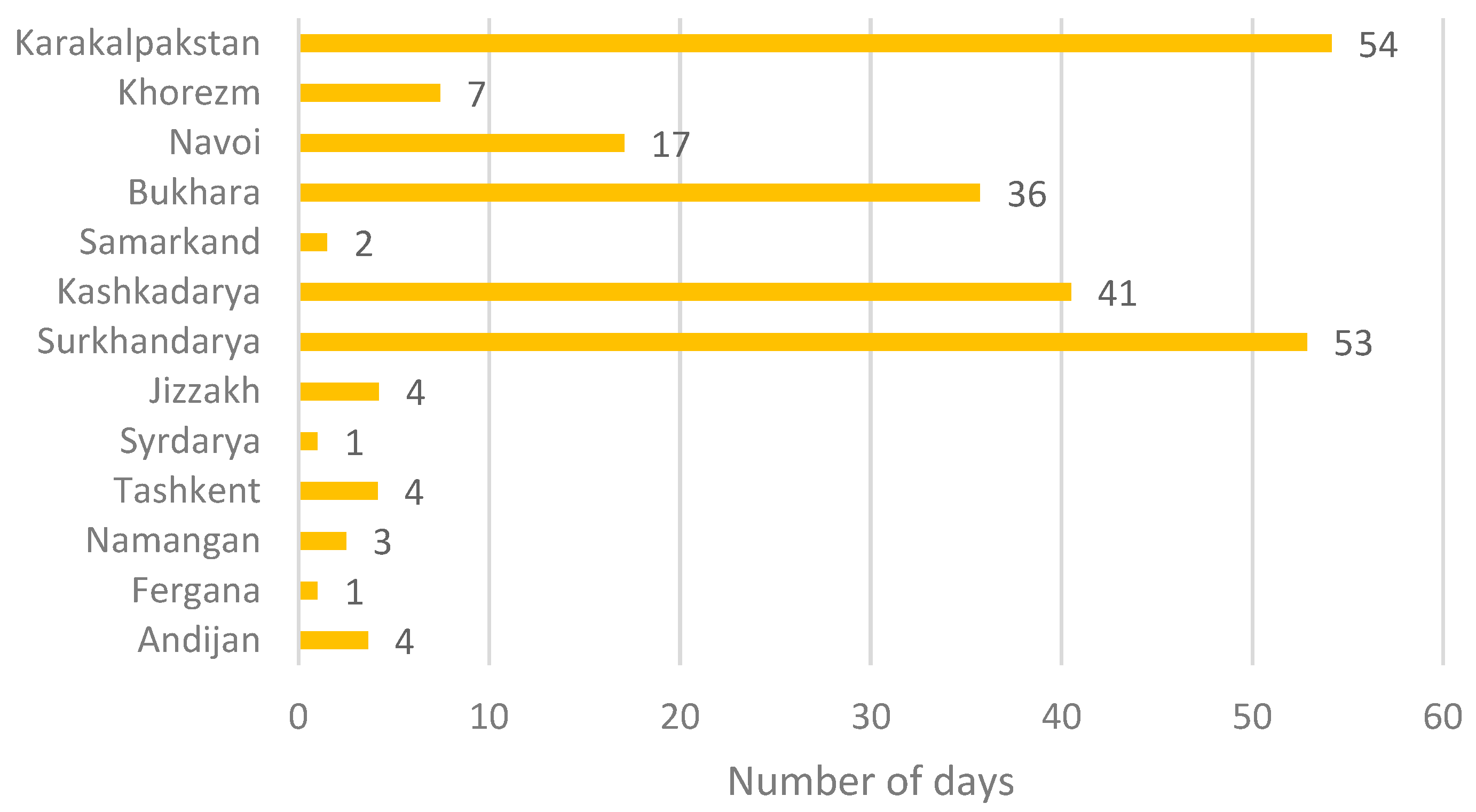
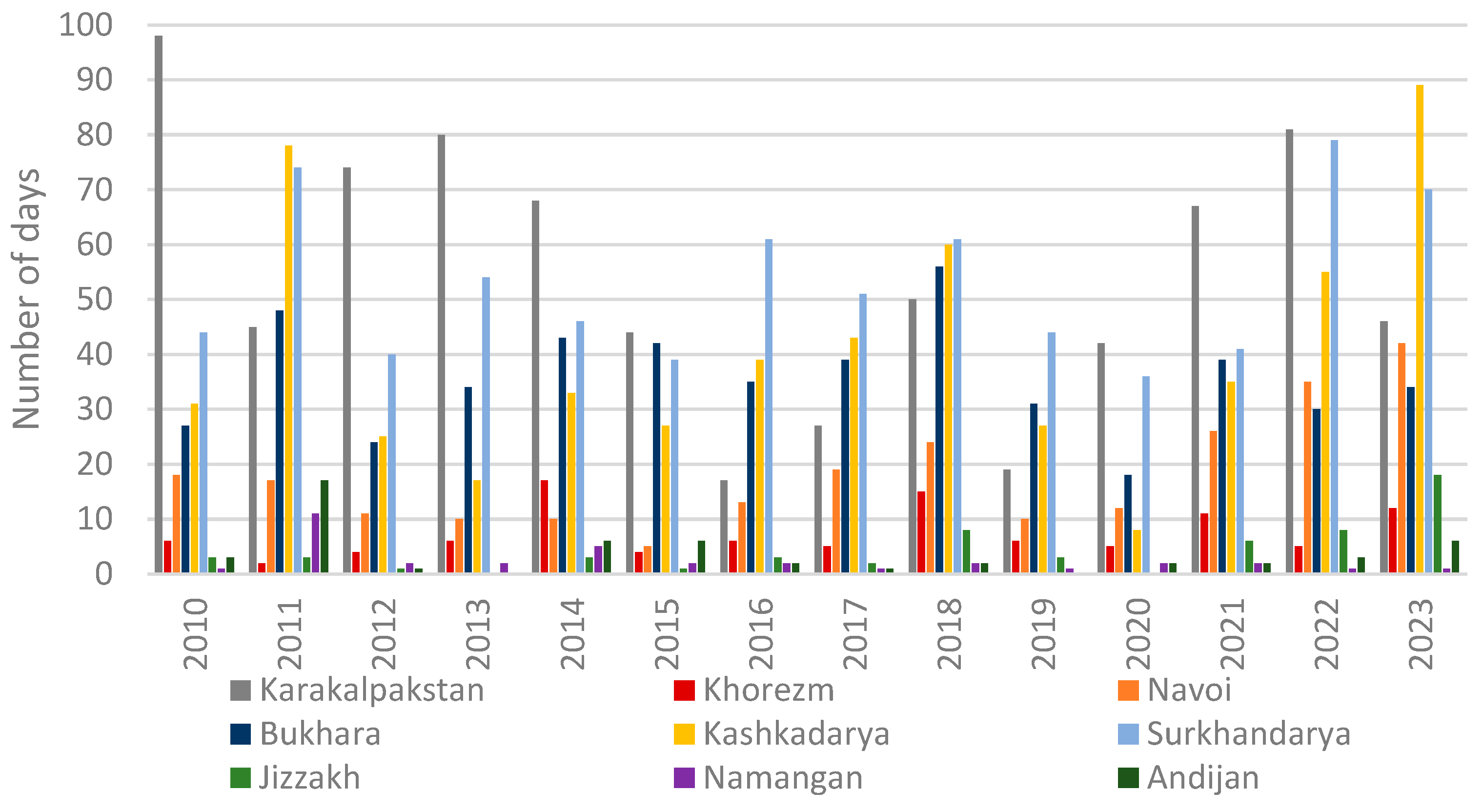


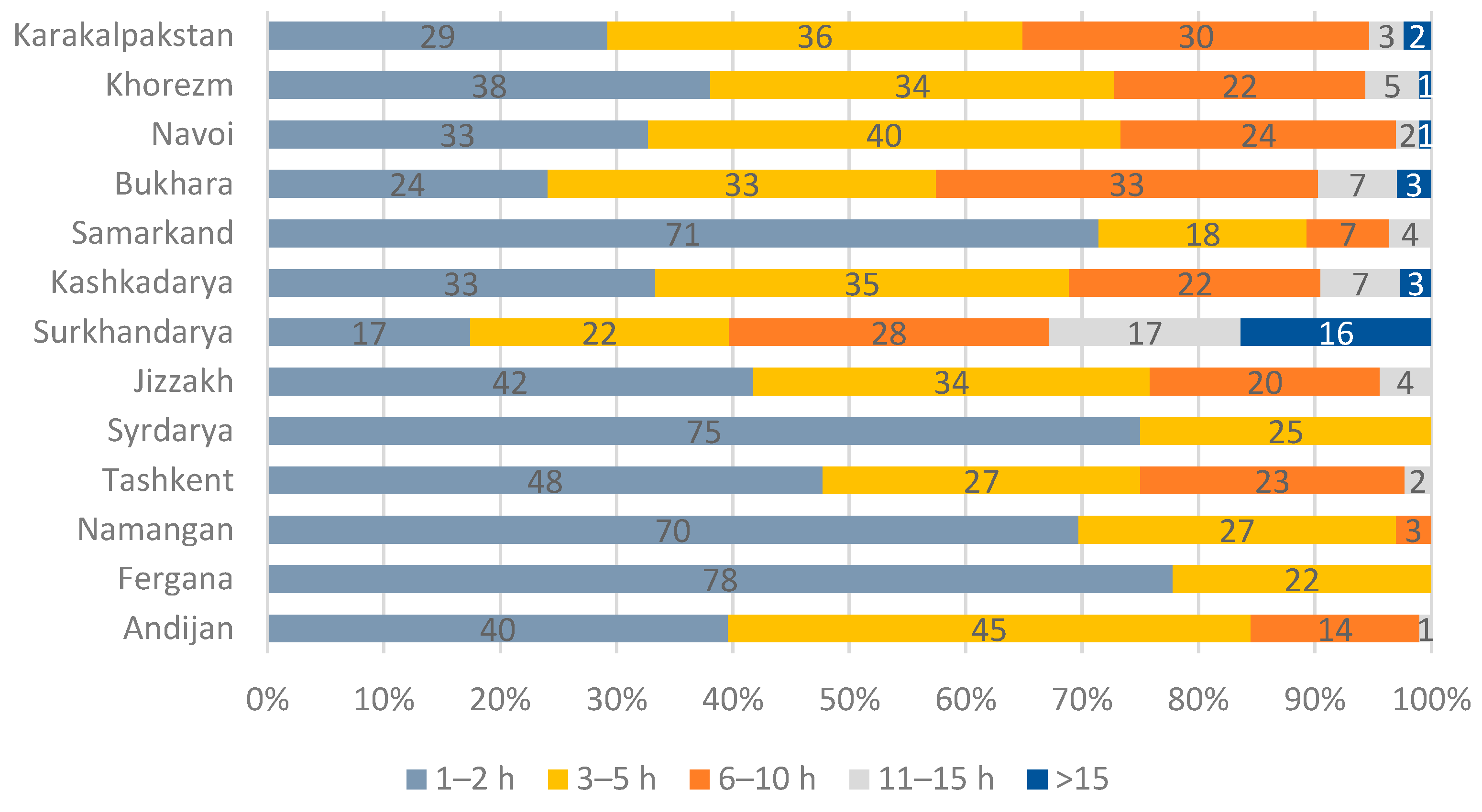
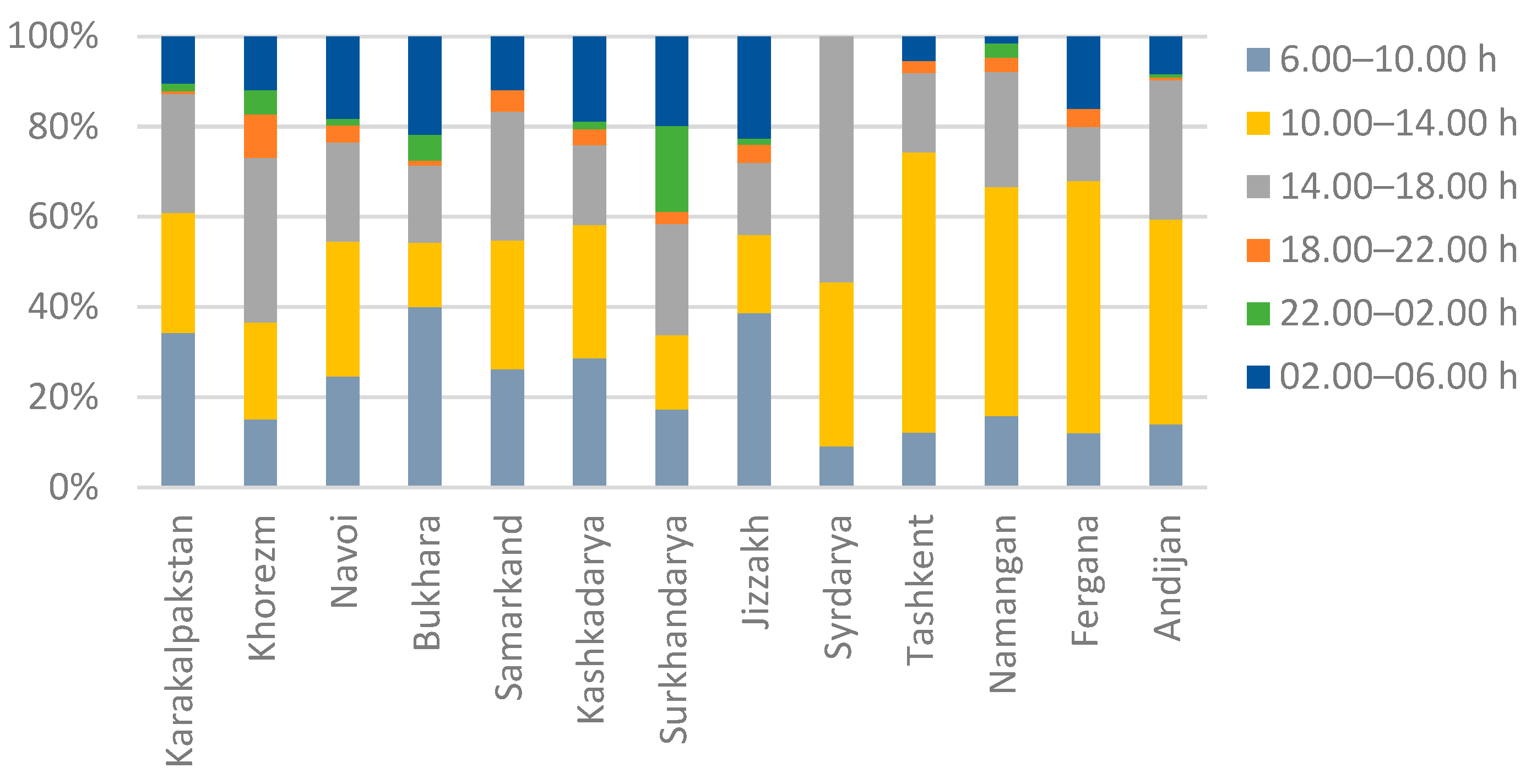
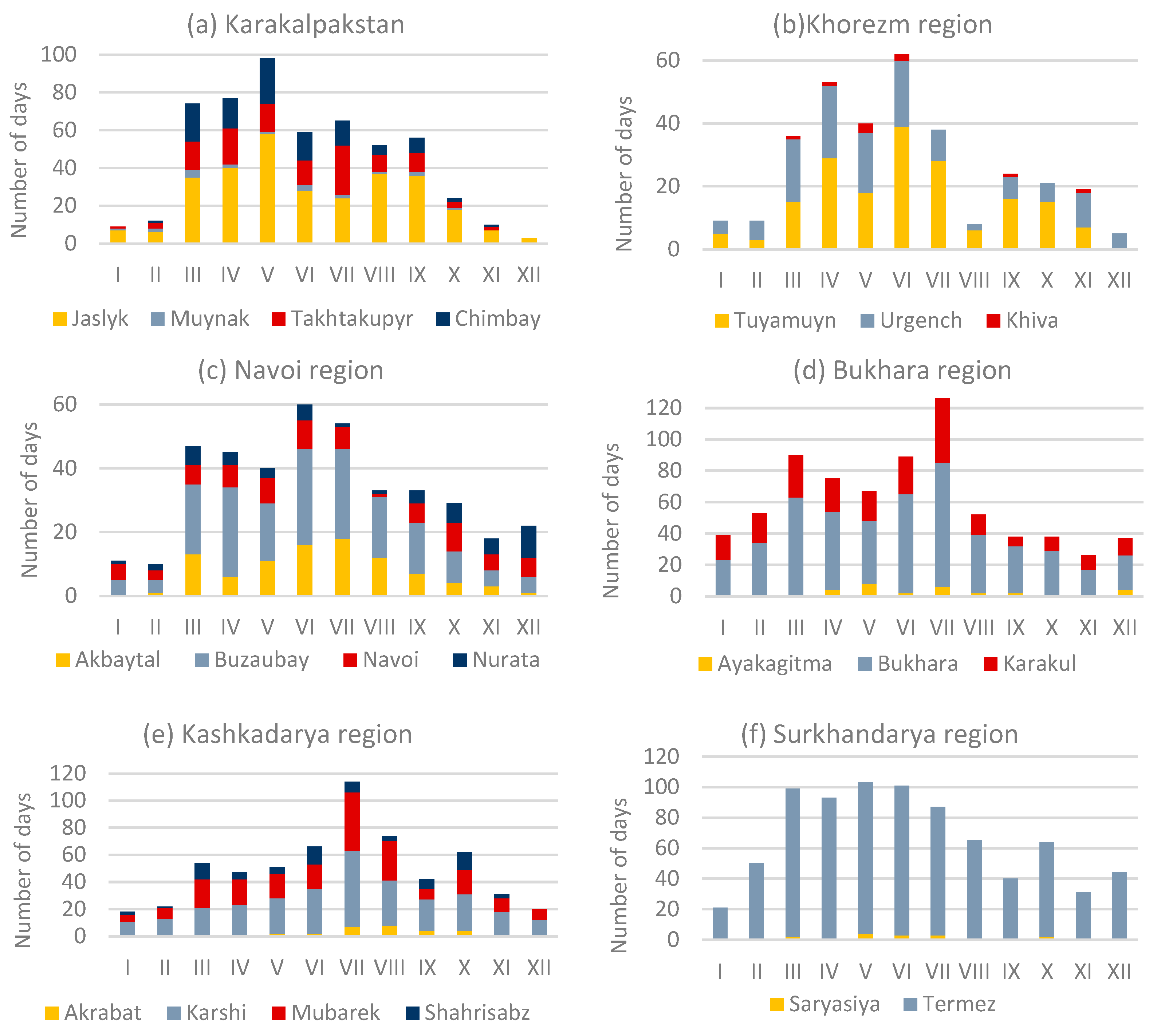



Disclaimer/Publisher’s Note: The statements, opinions and data contained in all publications are solely those of the individual author(s) and contributor(s) and not of MDPI and/or the editor(s). MDPI and/or the editor(s) disclaim responsibility for any injury to people or property resulting from any ideas, methods, instructions or products referred to in the content. |
© 2025 by the authors. Licensee MDPI, Basel, Switzerland. This article is an open access article distributed under the terms and conditions of the Creative Commons Attribution (CC BY) license (https://creativecommons.org/licenses/by/4.0/).
Share and Cite
Rakhmatova, N.; Nishonov, B.E.; Shardakova, L.; Akhmedova, A.; Khudoyberdiev, A.; Rakhmatova, V.; Belikov, D.A. Temporal and Spatial Dynamics of Dust Storms in Uzbekistan from Meteorological Station Records (2010–2023). Atmosphere 2025, 16, 782. https://doi.org/10.3390/atmos16070782
Rakhmatova N, Nishonov BE, Shardakova L, Akhmedova A, Khudoyberdiev A, Rakhmatova V, Belikov DA. Temporal and Spatial Dynamics of Dust Storms in Uzbekistan from Meteorological Station Records (2010–2023). Atmosphere. 2025; 16(7):782. https://doi.org/10.3390/atmos16070782
Chicago/Turabian StyleRakhmatova, Natella, Bakhriddin E. Nishonov, Lyudmila Shardakova, Albina Akhmedova, Alisher Khudoyberdiev, Valeriya Rakhmatova, and Dmitry A. Belikov. 2025. "Temporal and Spatial Dynamics of Dust Storms in Uzbekistan from Meteorological Station Records (2010–2023)" Atmosphere 16, no. 7: 782. https://doi.org/10.3390/atmos16070782
APA StyleRakhmatova, N., Nishonov, B. E., Shardakova, L., Akhmedova, A., Khudoyberdiev, A., Rakhmatova, V., & Belikov, D. A. (2025). Temporal and Spatial Dynamics of Dust Storms in Uzbekistan from Meteorological Station Records (2010–2023). Atmosphere, 16(7), 782. https://doi.org/10.3390/atmos16070782







